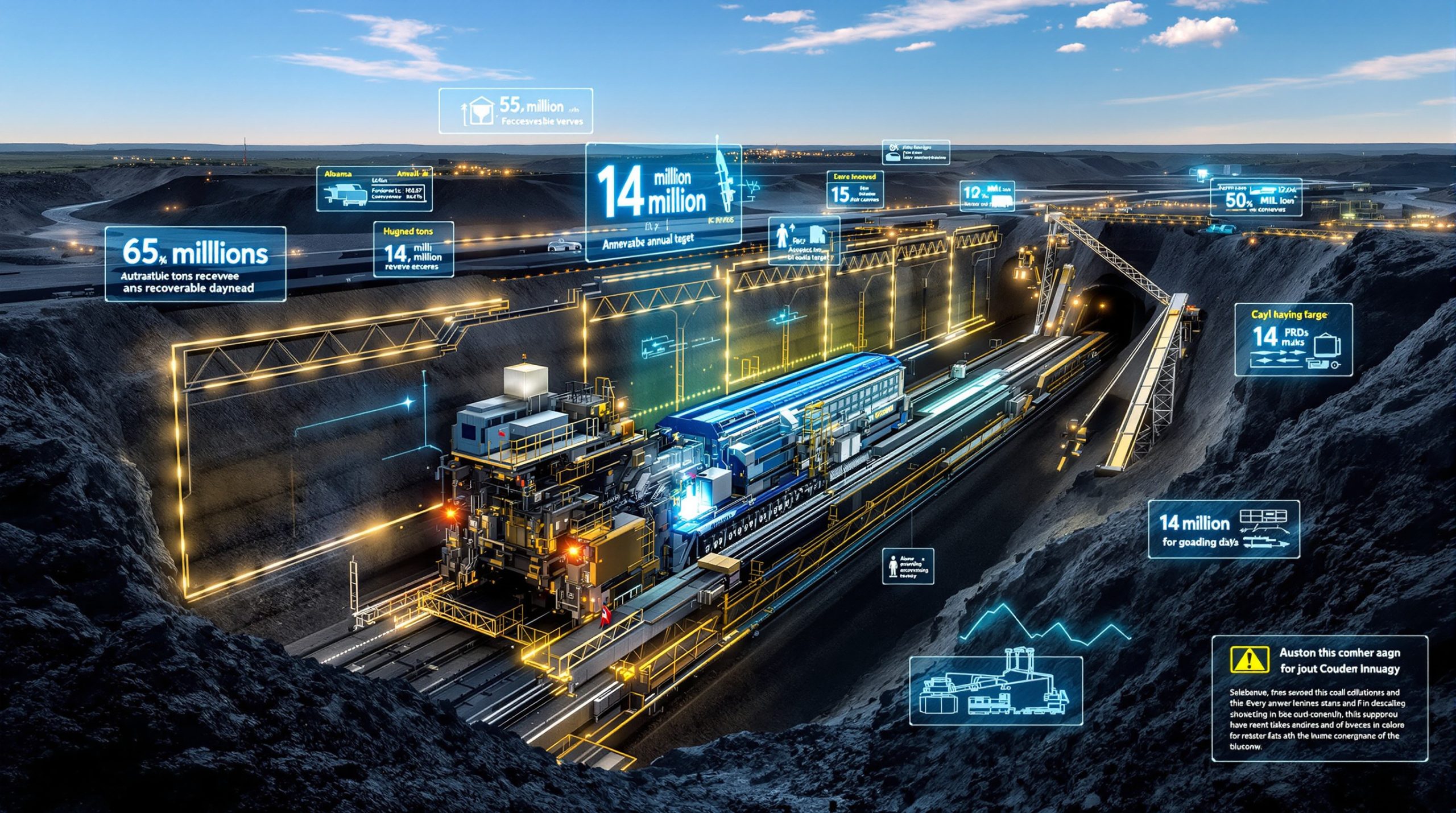Understanding EXIM Financing for Syerston Scandium Project: Strategic Implications
The global critical minerals landscape is experiencing a significant development with the Syerston Scandium Project in Australia garnering international financial support. As nations seek to secure supply chains for strategic materials, this project represents a pivotal development in the critical minerals sector with far-reaching implications for industrial applications, geopolitical relations, and market dynamics.
What is the Syerston Scandium Project?
Project Overview and Strategic Importance
Located in New South Wales, Australia, the Syerston Scandium Project hosts what industry experts describe as the world's largest and highest-grade scandium deposit. This strategic minerals importance sits in a geographically advantageous position with access to essential infrastructure networks including highways, rail connections, and shipping routes, making it logistically viable for commercial development.
The project has recently completed key regulatory milestones, securing necessary environmental and development permits from the New South Wales government. This progression demonstrates the project's compliance with Australia's stringent regulatory framework, which is known for maintaining high environmental standards while supporting resource development.
Sunrise Energy Metals, the ASX and OTC-listed company developing the project, continues active community engagement as part of their development strategy. This approach aligns with contemporary expectations for resource projects to maintain social license through transparent stakeholder consultation.
A comprehensive feasibility study is currently underway, with completion expected by mid-to-late October 2025. This timeline positions the project for potential investment decisions before year-end, assuming favorable study outcomes and market conditions.
Recent Resource Expansion
A significant milestone for the project came with the recent mineral resource update, which confirmed 19,000 tonnes of contained scandium at an impressive average grade of 414 g/t. This resource classification falls within the measured and indicated categories, providing high confidence in the geological understanding of the deposit.
This resource estimate represents a substantial expansion from previous assessments, underscoring the project's potential significance in global scandium supply. The updated resource parameters are now being incorporated into an optimized mine plan as part of the final feasibility study, potentially enhancing the project's economic profile.
How Does EXIM Bank Financing Work for Critical Minerals?
EXIM Bank's Letter of Interest Details
In a development with significant implications for project financing, the Export-Import Bank of the United States (EXIM) has issued a letter of interest for up to US$67 million (approximately A$103 million) in potential debt financing for the Syerston project. This amount would cover approximately 50% of the estimated development capital required to bring the project into production.
This preliminary financing interest is subject to a formal application process and comprehensive due diligence review by EXIM before any binding lending commitment would be made. The initial letter of interest signals EXIM's recognition of the project's strategic alignment with U.S. industrial policy objectives.
While specific repayment terms haven't been publicly disclosed, EXIM financing example for critical infrastructure and strategic resource projects typically offers attractive conditions that may extend up to 15 years, providing extended payback periods that enhance project economics.
EXIM Financing Programs Applicable to Scandium
EXIM's interest in the Syerston project appears to align with several of its strategic initiatives, including its Supply Chain Resiliency Initiative and the China Transformational Exports Program. These programs reflect the U.S. government's growing focus on securing critical mineral supply chains outside of geopolitically sensitive regions.
This financing approach represents a strategic response to identified vulnerabilities in global supply networks, particularly following China's implementation of export controls on rare earth metals earlier in 2025. EXIM's willingness to support allied nations' resource development projects signals a shift toward "friend-shoring" critical supply chains.
The financing interest demonstrates practical implementation of the U.S. policy designation of scandium as strategically important to industrial supply chains. This policy framework provides the foundation for financial instruments like EXIM support to be deployed for resource security objectives.
Why is Scandium Considered a Critical Mineral?
Strategic Applications of Scandium
Scandium has earned its critical mineral designation through its unique properties and growing importance across multiple high-value applications. According to industry leaders, scandium serves as a vital component in wireless communications technologies, playing an increasingly important role in next-generation connectivity solutions.
In aerospace and defense applications, scandium-aluminum alloys offer exceptional strength-to-weight advantages, with even small additions of scandium (typically 0.1-0.5%) providing significant performance improvements. These alloys enable the production of lighter yet stronger components, enhancing fuel efficiency and performance in transportation applications.
The clean energy transition also relies on scandium, particularly in solid oxide fuel cells where it improves electrical conductivity and operational stability at high temperatures. This application could see substantial growth as hydrogen and other alternative energy systems gain market adoption.
The growing integration of scandium across civilian and defense manufacturing creates a strategic imperative for secure supply, particularly as industries seek materials that enable weight reduction, performance enhancement, and energy efficiency.
Global Supply Challenges
Current global scandium production remains extremely limited, with annual output estimated at less than 25 tonnes globally. This production constraint has historically limited wider commercial adoption despite the material's valuable properties.
The supply situation became more precarious following China's implementation of export controls on rare earth metals earlier in 2025. These controls highlighted the vulnerability of global supply chains that rely heavily on Chinese production and processing capacity.
Recent geopolitical tensions have exposed broader critical minerals energy security vulnerabilities, creating urgency around developing alternative sources in politically stable jurisdictions. The concentration of existing production in a limited number of operations, many as byproducts of other mining activities, contributes to market uncertainty.
Industrial demand for scandium continues to grow as technical applications expand, creating a supply-demand imbalance that supports the economic case for new dedicated production sources like the Syerston project.
What Are the Geopolitical Implications of This Financing?
US-Australia Critical Minerals Partnership
The EXIM financing interest in Syerston represents a tangible manifestation of strengthening resource cooperation between the United States and Australia. This relationship builds on Australia's position as a key U.S. ally with significant endowments of strategic metals.
This financial support demonstrates practical implementation of diversification strategies away from Chinese supply dominance, particularly following China's implementation of export controls earlier in 2025. The approach aligns with broader "friend-shoring" policy objectives that seek to build resilient supply chains among aligned nations.
The financial commitment signals practical implementation of Indo-Pacific economic security initiatives that have become increasingly important in Western strategic planning. By supporting Australian resource development, the U.S. demonstrates commitment to building practical alternatives to existing supply networks.
This cooperative approach highlights how financial instruments can be deployed to achieve Trump's critical minerals order objectives without requiring direct government ownership of resources or production facilities.
Industrial Strategy Considerations
From an industrial strategy perspective, this financing approach supports securing access to materials essential for advanced manufacturing in sectors ranging from aerospace to telecommunications. The focus on scandium reflects its growing importance in high-performance applications and emerging technologies.
Supporting allied nations' processing capabilities represents an important element of supply chain resilience, moving beyond raw material extraction to value-added processing. This approach creates more comprehensive industrial ecosystems rather than simply relocating extraction activities.
The financing demonstrates a practical response to vulnerabilities exposed by recent supply disruptions and price volatility in critical minerals markets. By supporting projects with substantial resources and long potential production lives, these investments aim to create structural stability in supply networks.
This approach represents strategic positioning in technology supply networks that will support manufacturing capabilities for decades to come. Rather than addressing immediate shortages, these investments focus on building sustainable supply alternatives aligned with long-term industrial objectives.
What Steps Remain Before Project Development?
Financing and Investment Decision Timeline
The project's immediate focus remains on completing the comprehensive feasibility study, expected in mid-to-late October 2025. This study will incorporate the expanded resource estimate and optimized mine planning to establish definitive project economics.
Following study completion, Sunrise Energy Metals would need to progress through a formal EXIM financing application and due diligence process to convert the letter of interest into a binding commitment. This process involves detailed technical, financial, and compliance reviews.
Concurrent efforts would focus on securing the remaining project financing, representing approximately 50% of capital requirements not covered by the potential EXIM facility. These funding sources could include equity partners, additional debt facilities, or ASX capital raising methods.
With financing secured, the Sunrise Energy Metals board would proceed to a final investment decision, weighing project economics, market conditions, and strategic considerations. This decision would establish the timeline for commencement of detailed engineering and construction activities.
Customer and Offtake Arrangements
Securing binding offtake agreements remains a critical pathway to project development, with EXIM support potentially strengthening customer engagement. According to company management, efforts are underway to convert interest into binding commercial relationships.
Establishing appropriate pricing mechanisms and contract structures presents both challenges and opportunities in a market without transparent benchmark pricing. These arrangements must balance producer certainty with flexibility to capture future market upside.
Technical alignment with end-user requirements remains essential, ensuring that product specifications meet the exacting standards required for high-performance applications. This alignment requires close cooperation with potential customers during project development.
Creating market certainty through these commercial relationships provides a foundation for project financing, demonstrating revenue potential to support capital investment. The interrelated nature of financing and offtake highlights the integrated approach required for project advancement.
How Does This Project Impact the Global Scandium Market?
Market Transformation Potential
The Syerston project represents a potential step-change in global scandium availability, with capacity to significantly increase worldwide production from current limited levels. This expanded supply could facilitate wider adoption of scandium across its potential applications.
Reliable, large-scale supply could contribute to price stabilization, addressing the historical volatility and uncertainty that has limited commercial adoption. More predictable pricing enables manufacturers to incorporate scandium into long-term product development planning.
Increased availability would potentially enable wider commercial adoption of scandium-enhanced materials across industries from aerospace to telecommunications. The circular relationship between supply certainty and market development has historically constrained scandium utilization.
The project's development would contribute to creating more diverse and resilient supply chains for this critical material. This diversification aligns with broader industrial objectives to reduce concentration risk in strategic supply networks.
Australia's emergence as a dominant global supplier would reshape market dynamics currently dominated by limited production from Russia, China, and scattered byproduct recovery operations. This shift could establish new market structures and commercial frameworks for scandium trade.
Comparison to Current Global Supply
With current global scandium production estimated at less than 25 tonnes annually, the Syerston resource of 19,000 tonnes represents decades of potential supply at current consumption rates. This scale difference highlights the transformative potential of dedicated primary production.
The project's scale advantage compared to existing smaller operations could enable more efficient production economics and stable supply capabilities. Most current production comes as byproducts from other mining operations, creating inherent limitations on production flexibility.
The Syerston development would position Australia to meet growing demand from emerging applications that have been constrained by supply uncertainty. This capacity could unlock latent demand from manufacturers who have been reluctant to design scandium into products without supply assurance.
As a reliable non-Chinese supplier, Syerston would provide an alternative source for industries seeking supply chain diversification following recent export control implementations. This positioning aligns with broader industrial policy objectives in Western economies.
What Are the Project Economics and Development Considerations?
Capital and Operating Cost Structure
The total development capital for the Syerston scandium project is estimated at approximately US$134 million, calculated from EXIM's potential contribution representing about 50% of required funding. This capital intensity must be evaluated against the project's production capacity and expected revenue streams.
The project may benefit from a phased development approach, allowing for scaled investment that matches market development and reduces initial capital requirements. This approach could improve risk profiles for early-stage financing.
Processing technology selection and optimization represents a key determinant of both capital requirements and operating performance. Scandium extraction and purification require specialized techniques to achieve the high purity levels demanded by aerospace and electronics applications.
The project benefits from significant infrastructure and logistics advantages due to its location in New South Wales with access to transportation networks, power infrastructure, and skilled workforce availability. These advantages potentially reduce development complexity and operating costs.
While detailed operating cost profiles remain confidential pending feasibility study completion, the project's substantial resource grade suggests potential for competitive production economics. The 414 g/t average grade provides material advantages compared to lower-grade alternatives.
Environmental and Social Governance Factors
The project benefits from Australia's established regulatory framework, which provides clear processes for environmental approval while maintaining high standards of compliance. This regulatory certainty reduces development risk compared to jurisdictions with less transparent processes.
Sunrise Energy Metals has made sustainable development commitments integral to the project planning process, recognizing contemporary expectations for responsible resource development. These commitments address environmental management, community engagement, and operational sustainability.
Community engagement processes remain ongoing, with the company working to maintain social license through transparent consultation and benefit-sharing approaches. These efforts recognize the importance of community support for successful project development.
Environmental management strategies address water management, land rehabilitation, and emissions control to minimize ecological impact. These considerations are increasingly important for project financing as ESG criteria become more central to investment decisions.
The project's ESG profile represents a significant consideration for project financing, with financial institutions increasingly incorporating sustainability metrics into lending decisions. Australia's strong governance framework provides advantages in accessing this financing compared to projects in less regulated jurisdictions.
FAQs About the Syerston Scandium Project
What makes scandium valuable as a critical mineral?
Scandium's exceptional properties create value across multiple high-technology applications. When added to aluminum alloys in small quantities (typically 0.1-0.5%), scandium significantly enhances strength, corrosion resistance, and heat tolerance while reducing weight. These properties make scandium-aluminum alloys particularly valuable in aerospace, defense, and transportation applications where performance requirements are demanding.
Beyond structural materials, scandium serves as an essential component in solid oxide fuel cells, enhancing electrical conductivity and operational stability at high temperatures. This application positions scandium as increasingly important for clean energy technologies as hydrogen and alternative energy systems gain market adoption.
In telecommunications, scandium components support advanced wireless communication technologies, contributing to network performance in an increasingly connected world. As connectivity demands grow, these applications represent an expanding market for scandium.
Why is the U.S. interested in financing an Australian scandium project?
The U.S. interest in financing the Syerston project reflects a strategic response to vulnerabilities in critical mineral supply chains, particularly following China's implementation of export controls on rare earth metals earlier in 2025. This policy shift highlighted the risks of concentrated supply dependencies.
By supporting resource development in allied nations like Australia, the U.S. pursues a "friend-shoring" strategy that builds resilient supply networks among politically aligned countries. This approach recognizes Australia's position as a key ally with significant endowments of strategic metals.
The financing aligns with broader U.S. industrial policy objectives to secure access to materials vital for advanced manufacturing and defense applications. Scandium's growing importance in aerospace, telecommunications, and clean energy makes it particularly relevant to emerging technology priorities.
How does this project compare to other scandium developments globally?
The Syerston project contains what is described as the world's largest and highest-grade scandium resource, with 19,000 tonnes of contained scandium at an average grade of 414 g/t. This resource scale and quality distinguishes it from smaller operations that typically produce scandium as a byproduct.
Most existing scandium production comes as a secondary product from other mining operations, including titanium, uranium, rare earth, and nickel laterite processing. This byproduct status creates inherent limitations on production flexibility and scale.
As a dedicated, large-scale primary producer, Syerston would potentially transform global supply dynamics by introducing predictable, substantial production capacity. This transformation could enable more stable pricing and supply certainty that would support broader commercial adoption.
What timeline is expected for project development?
Following the completion of the feasibility study expected in mid-to-late October 2025, Sunrise Energy Metals would progress through financing arrangements including the formal EXIM application process. This financing phase could extend through early 2026, depending on due diligence requirements and market conditions.
Assuming positive study outcomes and successful financing arrangements, the company could proceed to a final investment decision in 2026. This decision would initiate detailed engineering, procurement, and construction planning activities.
Construction timelines would depend on equipment procurement schedules and site preparation requirements, but typically range from 12-18 months for projects of similar scale and complexity. This timeline suggests potential first production in late 2027 or early 2028, assuming no significant delays.
Commercial production ramp-up would likely proceed in phases, matching market development and customer qualification processes. This gradual approach allows for optimization of operations and market development in parallel.
The Future of Critical Mineral Supply Chains
The Syerston scandium project represents more than a single resource development; it exemplifies the evolving approach to critical mineral supply chains in a changing geopolitical landscape. By combining financial support from allied nations with Australia's resource endowment, the project demonstrates practical implementation of supply chain resilience strategies.
As industries increasingly rely on specialized materials for technological advancement, securing diverse and stable supply sources becomes essential for economic security. The Syerston development potentially provides both immediate supply diversification and a model for future critical mineral projects.
The coming months will prove decisive as the project advances through feasibility completion, financing arrangements, and investment decisions. These milestones will determine whether this significant resource transitions from geological potential to production reality, with corresponding implications for global scandium markets and strategic material supply chains.
Disclaimer: This article contains forward-looking statements regarding project development timelines, production potential, and market impacts. Actual outcomes may differ materially from these projections due to technical, financial, regulatory, or market factors beyond current knowledge. Readers should consider these statements as speculative and conduct independent due diligence before making investment or business decisions based on this information.
Want to Identify the Next Major ASX Mining Discovery?
Discover high-potential ASX mineral discoveries before the market catches on with Discovery Alert's proprietary Discovery IQ model, offering real-time alerts that transform complex geological data into actionable investment insights. Explore why major discoveries can lead to exceptional returns by visiting the dedicated discoveries page.




